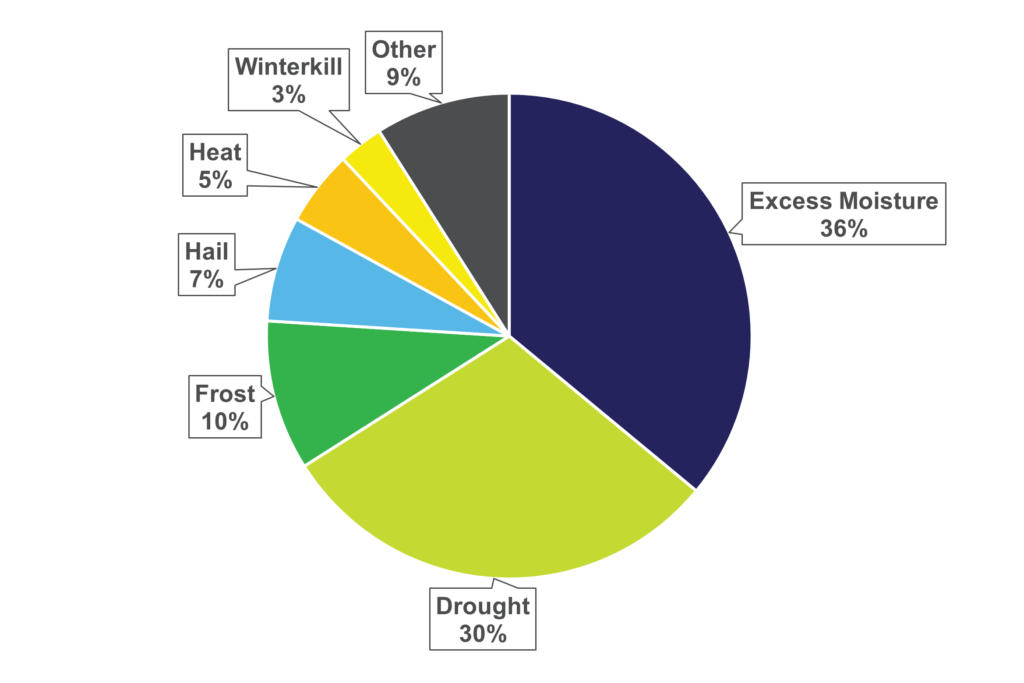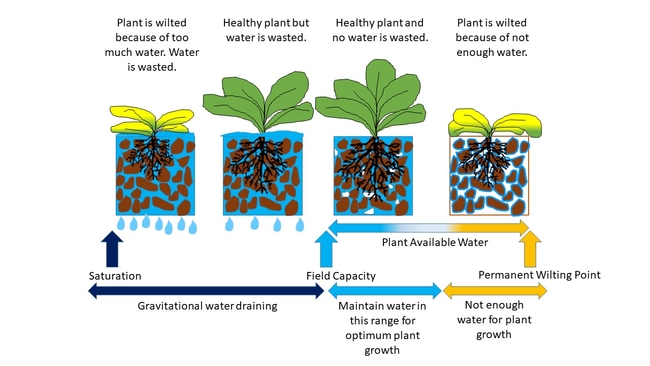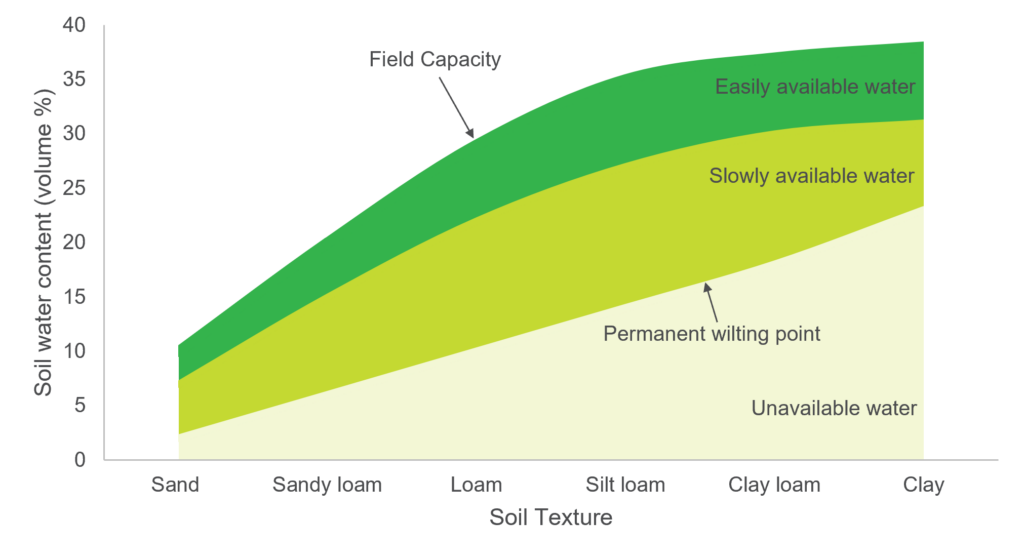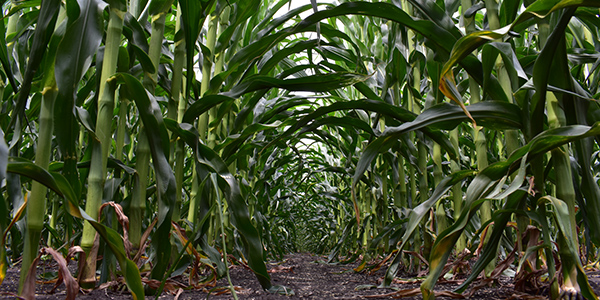Section Title
Managing Extremes of Moisture Part 1: Soil Properties and Definitions
- Whole Farm
This is Part 1 of a three-part series on managing extremes of moisture. Part 2 focuses on crop selection, pests and fertility, and Part 3 focuses on field activities.
Manitoba farmers are no strangers to moisture extremes, which are one of the greatest threats to crop production (Figure 1). Farmers across the province must often cope with both drought and excess moisture, often in quick succession.

Figure 1: Historical causes of crop loss, 1966-2021. (Source: Manitoba Agricultural Services Corporation)
Soil Water Definitions
When considering moisture management, we must first understand what is meant by some commonly used terms:
- Saturation: The moisture content at which all soil pores are filled with water.
- Field Capacity: The moisture content at which water in larger pores has drained due to gravity, but smaller pores are still water-filled.
- Permanent Wilting Point: The moisture content at which plants can no longer remove water from the soil. Water still present in the soil is so tightly held by soil particles that it cannot be extracted.
- Plant Available Water: The amount of water in the soil that can be used by plants. The amount of plant available water in a soil is the difference between the field capacity and permanent wilting point.

Figure 2: Relationship between soil water and plant growth. (Source: Vasudha Sharma, Basics of irrigation scheduling, University of Minnesota Extension. Used with permission.)
When considering our options to manage soil moisture, there are several soil properties that are especially important to consider:
- Water holding capacity: The amount of moisture a soil can hold for plant uptake.
- Soil texture: The proportion of sand, silt and clay particles in a soil. Soil texture cannot readily be changed, but strongly influences the water holding capacity of a soil. The larger pores of a sandy soil will allow water to move through quickly, whereas the small pores of a clay soil will hold water (Figure 3). For more information on the importance of soil texture with respect to water, see this resource from the University of Wisconsin-Madison.

Figure 3: General relationship between soil texture and water holding capacity. Values for individual soils will differ from those shown. Adapted from Brady and Weil (2008).
- Soil structure: The arrangement of soil particles into aggregates. Good soil structure allows easier penetration of plant roots, ensures good soil aeration, and can improve water drainage into and through the soil.
- Soil organic matter: Organic matter plays a critically important role in the soil, including acting as a “glue” to improve or maintain soil structure, and by contributing to the water holding capacity of the soil. The amount of organic matter in a soil is affected by many factors, including the type of crops grown, the amount of crop residue returned to the soil, the addition of manure, tillage activities and the original organic matter content of the soil prior to cultivation. Soil organic matter can help “buffer” soil from moisture extremes by improving water infiltration under excess moisture conditions, and improving water holding capacity under drought conditions.

Figure 4: Effect of increasing organic matter content on field capacity and permanent wilting point of silt loam soils. The difference between the field capacity and permanent wilting point is the useful moisture available to plants. Adapted from Brady and Weil (2008).
The issue of extreme moisture conditions in Manitoba is a complex one, and many factors that affect soil moisture cannot be controlled (precipitation, soil texture). There are, however, several important factors that we can control, at least to some extent (evaporation, soil water holding capacity, infiltration, runoff).
When considering management practices that may be impactful, imagine a toolbox, with the drawers containing useful management tools (Figure 5). While not every tool will be a fit for your farm or challenge, incorporating those that are appropriate can help build resiliency on your farm, and a resilient cropping system can better withstand both drought and excess moisture.
Measures and Predictions of Moisture and Capacity
Current soil moisture can be determined with relative ease (information from Manitoba Agriculture on how to do so is available here). The bigger challenge is predicting future moisture. Long-term precipitation averages and lived experience are often the relied upon methods, but some work in Manitoba is being done to develop forecasting tools. The Manitoba Forage and Grassland Association have a decision support tool that allows producers in the Assiniboine River Basin and Pembina Valley Watershed to forecast soil moisture, groundwater and surface water. Manitoba Crop Alliance has supported research to develop similar models in the Red River Valley.
With an understanding of soil water properties, the next step is to consider how the management strategies implemented on farm affect soil moisture. Part 2 of this three-part series focuses on crop selection, pests and fertility, and Part 3 focuses on field activities.
References
- Brady, N.C. and Weil, R.R. 2008. The Nature and Properties of Soils, 14th ed. Prentice-Hall, Upper Saddle River, NJ.
- Manitoba Agricultural Services Corporation. 2023. 2022/23 Annual Report. Available from: https://www.masc.mb.ca/masc.nsf/annual_report_2022_23.pdf
- Sharma, V. 2019. Basics of Irrigation Scheduling. University of Minnesota Extension. Available from: https://extension.umn.edu/irrigation/basics-irrigation-scheduling











